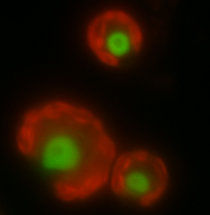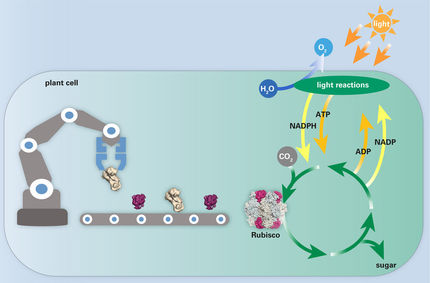Fishing in the sea of proteins
Composition of splicing complex in chloroplasts identified for the first time
To convert a gene into a protein, a cell first crafts a blueprint out of RNA. One of the main players in this process has been identified by researchers led by Dr. Jessica Jacobs at the Ruhr-Universität Bochum. The team “fished” a large complex of proteins and RNA, which is involved in the so-called splicing, from the chloroplasts of the green alga Chlamydomonas reinhardtii. This cuts non-coding regions out of the messenger RNA, which contains the protein blueprint. “For the first time, we have established the exact composition of an unknown splicing complex of the chloroplasts”, says Jacobs.

Fluorescence micrograph of Chlamydomonas reinhardtii. The nucleus of the algae is marked by a green fluorescent protein, the chloroplasts fluoresce red.
© Allgemeine und Molekulare Botanik, RUB
From gene to protein – craftwork required
Genes, the bearers of genetic information, contain coding and non-coding regions. To convert a gene into a protein, enzymes first create a copy of the gene, the messenger RNA. A useful blueprint for a protein is only obtained, however, when enzymes cut the non-coding regions, called introns out of the messenger RNA. Scientists call this process splicing. Large complexes of RNA and proteins are responsible for the splicing.
Components of the splicing complex identified in chloroplasts
The RUB researchers examined the splicing of the gene psaA, which is found in chloroplasts. These cellular constituents of plants which carry out photosynthesis probably originated from formerly free-living cyanobacteria. According to the endosymbiotic theory, the cyanobacteria lived in symbiosis with the plants and were eventually integrated into their cells. Chloroplasts therefore have their own genetic material – a relic from the cyanobacterial genome. However, the chloroplasts are dependent on the communication with the cell nucleus in order to be functional. The Bochum team identified the components of the protein complex that splices the chloroplast gene psaA. In the splicing complex they found 23 different proteins that are encoded in the genome of the cell nucleus. “The protein complex discovered gives us an insight into the functioning of components involved in the communication between chloroplasts and the nucleus”, says Jessica Jacobs.
How to fish a splicing complex
The team carried out its investigations on the unicellular green alga Chlamydomonas reinhardtii. “We used a protein bait to fish the splicing complex out of the chloroplasts”, says Jacobs. Before starting the experiment, it was known that the protein Raa4 is involved in the splicing of the psaA gene. The many interaction partners of Raa4, however, were unknown. The RUB biologists genetically altered the alga in such a way that it produced a modified form of the protein Raa4 – with a tag, i.e. a kind of “fish hook”. They isolated all the proteins of the cell and filtered them through a particular material, on which only Raa4 got caught on its fish hook – along with all of its bound interaction partners. They determined the components of the splicing complex fished out with the aid of mass spectrometry. The researchers found a splicing complex with the same composition for various environmental conditions: in light, darkness, and in an oxygen-free environment.
Original publication
Other news from the department science
Most read news
More news from our other portals
See the theme worlds for related content
Topic World Mass Spectrometry
Mass spectrometry enables us to detect and identify molecules and reveal their structure. Whether in chemistry, biochemistry or forensics - mass spectrometry opens up unexpected insights into the composition of our world. Immerse yourself in the fascinating world of mass spectrometry!

Topic World Mass Spectrometry
Mass spectrometry enables us to detect and identify molecules and reveal their structure. Whether in chemistry, biochemistry or forensics - mass spectrometry opens up unexpected insights into the composition of our world. Immerse yourself in the fascinating world of mass spectrometry!



















































